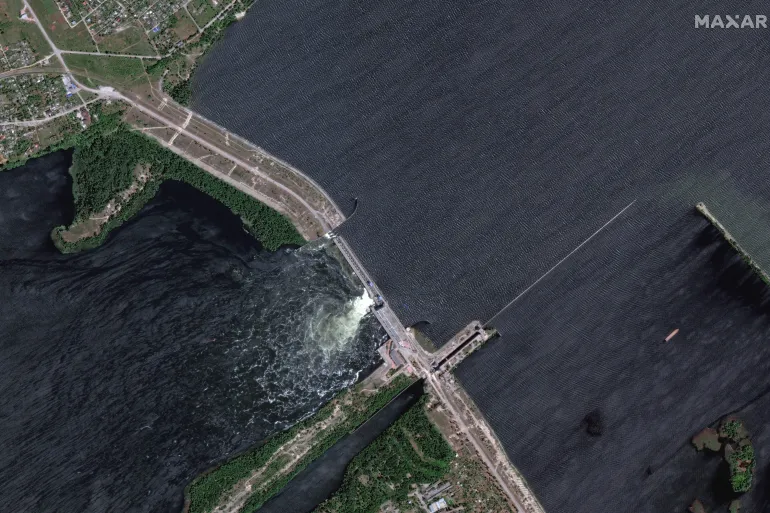Thousands of people fled their homes after a huge dam in the Russian-occupied area of southern Ukraine collapsed. Like an open floodgate for humanitarian catastrophe and wreaking environmental havoc.
The Norwegian seismic data pointed to an explosion around the time the dam collapsed, even as the blame game between the two high-contracting parties continues.
The Norwegian research foundation, Norsar, indicated that the data collected from the regional seismic station in Romania showed explosion signals. Although the foundation refrained from alleging or drawing conclusions.
Even though the disaster cause is not yet determined, both adversaries continue blame-shafting. While it may be intentional, it is not unique to the Russian-Ukraine war. History is filled with such events wherein the intentional destruction of dams and dykes was a method of warfare, dating back as far as the 16th century.
As the belligerents discovered, flooding would hinder the adversaries’ marching army.
The Dambusters raids occurred during the Second World War, when German dams were targeted, or during the Korean War when North Korea’s hydroelectric facilities were targeted.
Thousands of people in Ukraine are in peril after the destruction of the Kakhovka Dam.
Many risk being left homeless and in desperate need, compounding the misery Ukrainians face amid Russia’s full-scale invasion. pic.twitter.com/eBm4zayWFc
— UN Ukraine (@UN_Ukraine) June 6, 2023
Where was the dam?
On the Dnipro River, the Nova Kakhovka dam was built during the Soviet era and lies about 20 miles east of Kherson. The southern river bank is under Russian occupation, while the northern bank is under Ukrainian control.
It holds back a huge water reservoir. It was built in 1956 as part of the Kakhovka hydroelectric power plant. Earlier this week, video footage showed a gigantic breach in the dam, with water surging through it. While flooding downstream towards Kherson, upstream might struggle with a water deficit.
Although it is not definite when exactly the facility was damaged at first, satellite images reveal that its condition deteriorated over several days. Some speculation revolves around technical failure, as the facility has been operating for decades.
Furthermore, several Ukrainians and the dam operator said that Nova Kakhovka station was “fully destroyed” and could not be restored. As water surged through the massive breach, agricultural zones and multiple villages and towns were quickly flooded. Forcing thousands of individuals on both sides of the river to flee their houses.
Wreaking environmental havoc
Generating major ecological concerns as farmlands and settlements have been washed away and are likely to have a long-lasting impact on the socio-economic fabric and continue to wreak havoc on the biodiversity of the region.
Contamination
The river has been contaminated with 150 tonnes of industrial lubricants and oil. In addition, President Volodymyr Zelensky warned that another 300 tonnes were at risk of leaking.
Ukrainian Environment Minister Ruslan Strilets indicated the estimated cost of the environmental damage caused by the dam explosion, which is estimated at 50 million euros. (Reuters)
Furthermore, the Dnipro River flows back to the Black Sea, as does some oil. This has caused experts to be concerned about the possible effect on the marine ecosystem.
Oil contamination in water bodies has emerged as a significant environmental issue, posing grave risks to aquatic ecosystems. The oil forms a thin layer on the surface that blocks sunlight and hinders photosynthesis.
This further leads to a decline in water oxygen levels and a subsequent disruption in the entire food chain. Posing a severe threat as the long-lasting effects can lead to the decimation of entire species and irreparable damage to fragile ecosystems.
As per Ukrainian Defense Ministry data, the flooding has already killed 300 animals in the Nova Kakhovka Zoo.
Looming landmine threat
Landmines are dislodged by floodwaters, raising grave concerns not just for Kherson residents but for those coming to provide humanitarian assistance.
The head of the Red Cross’s weapon contamination unit, Erik Tollefsen, told the AFP news agency: “We knew where the hazards were. Now, we don’t know.”
“All we know is that they are somewhere downstream.”
Apart from the looming threat of landmines, the reservoir acts as the primary source of cooling water for the Zaporizhzhia Nuclear Power Plant, raising major safety concerns. Nevertheless, experts have reported, “no immediate risk” to the plant.
Current Situation
A report from UNOCHA reported that the floods in southern Ukraine have begun to recede four days after the destruction. Although, the disaster is still causing displacement and a rising need for humanitarian assistance.
.@UNReliefChief Martin Griffiths talks to UN News about the tireless work being done in the immediate & longterm to help #Ukrainians impacted by the dam disasterhttps://t.co/DOmxeyaQIE pic.twitter.com/TtLXZGU7vN
— UN News (@UN_News_Centre) June 10, 2023
Furthermore, Martin Griffiths, the head of OCHA, shed light on the UN’s three-phase response plan for southern Ukraine.
The first phase will be to continue to rescue people and deliver medical supplies and food aid. The next phase will aim at reaching those in need, which includes 700,000 people who at present lack safe drinking water.
The last phase involves examining the environmental and economic consequences of the disaster.

